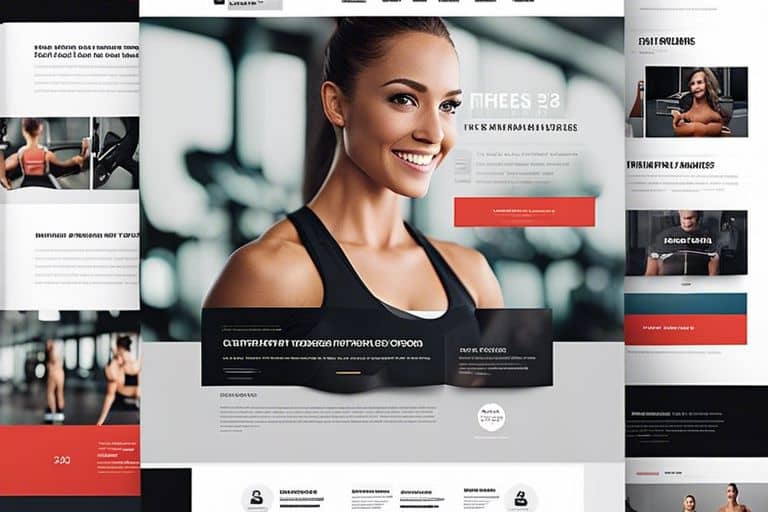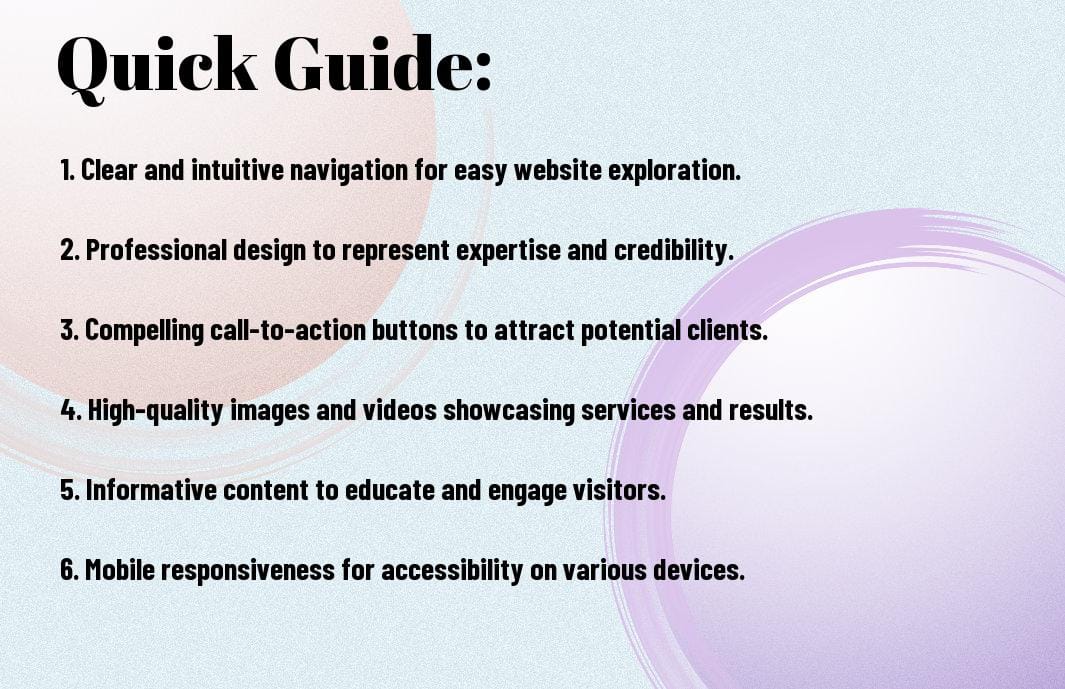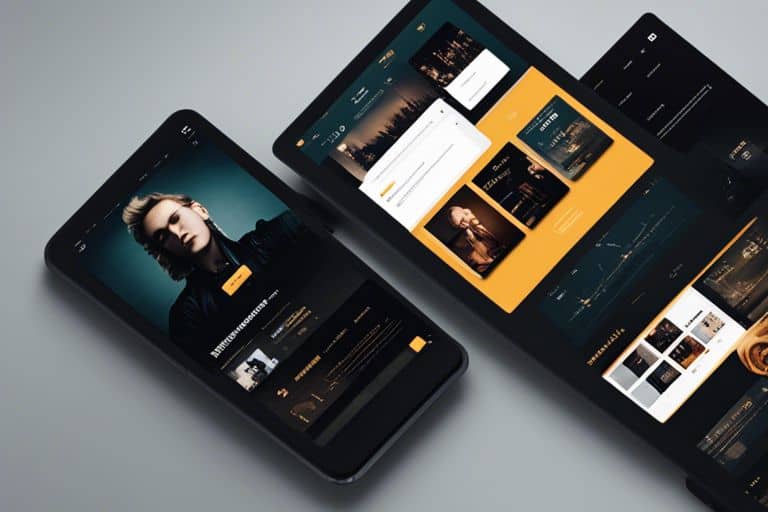
As far as creating a successful online presence as a personal trainer, there are key elements that can make or break your website design. These elements are crucial in attracting potential clients, showcasing your services, and ultimately growing your business. By incorporating the following top 5 elements into your personal trainer website design, you can ensure that your site is engaging, user-friendly, and effective in converting visitors into clients.
Key Takeaways:
- Clean and professional design: Keep the design of your personal trainer website clean and professional to make a positive first impression on potential clients.
- Easy navigation: Ensure that your website is easy to navigate with clear menu options and a user-friendly layout to improve user experience.
- Clear call-to-action: Include clear call-to-action buttons on your website to guide visitors on the next steps to take, such as booking a consultation or signing up for a training session.

The Visual Appeal: Engaging Your Audience
Importance of Professional Aesthetics
To effectively engage your audience, the visual appeal of your personal trainer website is crucial. Your website is often the first impression potential clients will have of your services, so it’s vital to make it visually appealing and professional. A clean, modern design with high-quality images and graphics can help establish credibility and trust with visitors.
To ensure that your website resonates with your target audience, investing in professional aesthetics is key. An aesthetically pleasing website design conveys that you are serious about your business and are committed to providing quality services. This can help attract new clients and retain existing ones by creating a positive and memorable user experience.
Tips for Selecting a Color Scheme and Graphics
When dicking out a color scheme for your personal trainer website, consider your branding and target audience. Colors can evoke emotions and convey messages, so choose a palette that aligns with your brand identity and the atmosphere you want to create. Additionally, incorporating high-quality graphics that showcase your expertise, such as workout images or client testimonials, can help engage visitors and showcase your skills.
- Choose colors that reflect your brand and target audience
- Incorporate high-quality graphics that enhance your content
Recognizing the impact of color psychology and visual elements on user experience, selecting the right color scheme and graphics can significantly enhance the overall appeal and effectiveness of your personal trainer website. By paying attention to these details, you can create a visually compelling website that attracts and retains clients.

User-Friendly Interface: Simplifying Navigation
The Role of Intuitive Design
Role: When considering designing a personal trainer website, the role of intuitive design cannot be overstated. Intuitive design focuses on creating a user-friendly experience by anticipating the needs and behaviors of visitors. It involves structuring the website in a way that makes it easy for users to navigate and find the information they are looking for effortlessly.
Intuitive design plays a crucial role in keeping visitors engaged and ensuring they have a positive experience on your website. By organizing content in a logical manner and providing clear navigation options, you can help users quickly locate the information they seek and encourage them to explore more of what your site has to offer.
Step-by-Step Guide to Organizing Content
StepbyStep: Organizing content effectively is key to ensuring that visitors can easily find the information they need on your personal trainer website. Here is a guide to help you organize your content in a clear and structured way:
| Step 1: Define your website’s objectives | Step 2: Create a clear hierarchy of information |
| Step 3: Use descriptive headings and subheadings | Step 4: Incorporate visual elements to break up text |
Organizing your content in a systematic manner not only enhances the user experience but also helps with search engine optimization, making your website more discoverable to potential clients.
UserFriendly: A user-friendly interface is imperative for simplifying navigation on your personal trainer website. By incorporating intuitive design elements and organizing content effectively, you can create a seamless user experience that encourages visitors to engage with your site and ultimately convert them into clients. Check out the table below for more tips on how to create a user-friendly interface:
| Tips for User-Friendly Interface: | Benefits: |
| Use clear and descriptive labels for navigation menus | Enhances usability and helps visitors find information quickly |
| Include search functionality for easy information retrieval | Improves user experience and allows for quick access to specific content |
Quality Content: Showcasing Your Expertise
Once again, when it comes to designing an effective personal trainer website, quality content is key. Your website is often the first point of contact between you and potential clients, so it’s necessary to showcase your expertise and credibility through the content you provide. By offering valuable and informative content, you can establish yourself as a trusted authority in the fitness industry.
To learn more about creating a high-performing personal trainer website, check out the 7 Elements of a High-Performing Personal Trainer Website.
Types of Content to Include
Pertaining to creating content for your personal trainer website, variety is key. Here are some types of content you can include to showcase your expertise and engage visitors:
- Blog posts: Share workout tips, nutrition advice, success stories, and industry news.
- Video content: Create workout tutorials, client testimonials, and exercise demos.
- Client testimonials: Highlight success stories and testimonials from satisfied clients.
- E-books or guides: Offer free resources on topics like nutrition, exercise, and goal setting.
- Infographics: Present information in a visually engaging and easy-to-understand format.
| Content | Examples |
| Blog posts | Workout tips, industry news |
| Video content | Exercise tutorials, client testimonials |
| Client testimonials | Success stories, satisfied clients |
| E-books or guides | Nutrition resources, goal setting tips |
| Infographics | Visually engaging information |
Tips for Creating Engaging and Informative Content
Content is king when it comes to your personal trainer website. Here are some tips for creating engaging and informative content that showcases your expertise:
- Create content that solves problems or addresses common questions in the fitness industry.
- Use a mix of written, visual, and interactive content to keep visitors engaged.
- Share your own unique perspective and insights to stand out from the competition.
- Consistently update your content to stay relevant and provide fresh information to visitors.
Knowing how to create content that resonates with your target audience is key to establishing yourself as a reputable personal trainer and attracting potential clients to your website.
Tips
Pertaining to showcasing your expertise on your personal trainer website, quality content is key. By providing valuable and engaging content, you can establish yourself as a trustworthy authority in the fitness industry.
- Create content that addresses common fitness questions and problems.
- Use a variety of content formats to keep visitors engaged and interested in your expertise.
- Consistently update and refresh your content to stay current and relevant to your audience.
- Showcase your unique perspective and insights to differentiate yourself from other personal trainers.
- Knowing how to create content that resonates with your target audience is crucial for building your online presence and attracting clients to your website.

Mobile Responsiveness: Catering to the On-the-Go Client
Factors Contributing to Mobile Compatibility
All personal trainer websites must be optimized for mobile devices to ensure a seamless experience for on-the-go clients. Factors contributing to mobile compatibility include responsive design, fast loading times, simplified navigation, and easy access to key information. A user-friendly layout that adjusts to different screen sizes is crucial for retaining visitors on your site. In addition, optimizing images and content for mobile viewing can improve the overall user experience.
- Responsive design
- Fast loading times
- Simplified navigation
- Access to key information
Knowing that many users access websites on their smartphones or tablets, it is necessary to prioritize mobile responsiveness in your personal trainer website design to attract and retain clients.
Pros and Cons of Different Mobile Design Approaches
Pertaining to designing a mobile-friendly personal trainer website, there are several approaches you can take, each with its own set of pros and cons. Understanding these can help you make an informed decision that best suits your business needs.
| Pros | Cons |
|---|---|
| Improved user experience | Requires additional design and development work |
| Higher search engine rankings | May lead to slower loading times |
Compatibility with a variety of devices is necessary for reaching a wider audience and providing a seamless browsing experience. Choosing the right mobile design approach can impact how visitors interact with your website and ultimately, your business success.
Search Engine Optimization: Maximizing Visibility
Search Engine Optimization (SEO) is crucial for your personal trainer website as it helps in increasing your visibility and driving organic traffic to your site. By implementing the right SEO strategies, you can improve your website’s ranking on search engine results pages (SERPs) and attract more potential clients.
Tips for Optimizing Your Site’s SEO
To enhance the SEO of your personal trainer website, focus on incorporating relevant keywords throughout your site. Conduct keyword research to identify popular search terms related to your services and integrate them naturally into your website content. Additionally, optimize your meta tags, headings, and image alt text with relevant keywords to improve your site’s visibility on search engines.
- Utilize long-tail keywords to target specific niches within the fitness industry.
- Regularly update your website content with fresh and engaging information to boost SEO performance.
- Ensure your site has a responsive design for optimal user experience and improved search rankings.
Knowing how to effectively optimize your website for search engines can help you reach a wider audience and increase your chances of attracting potential clients to your personal training services.
Step-by-Step Process for Keyword Integration
| Step 1: Keyword Research | Step 2: Content Optimization |
| Identify relevant keywords using tools like Google Keyword Planner. | Integrate keywords naturally into your website content, meta tags, and headings. |
An effective keyword integration strategy involves a systematic approach to researching and incorporating keywords into your website content. By following a step-by-step process, you can optimize your site for search engines and improve its visibility online.
Engine
| Step 3: Image Optimization | Step 4: Regular Monitoring and Updating |
| Include relevant keywords in image alt text and filenames. | Monitor your website’s performance using tools like Google Analytics and make necessary updates. |
Call to Action: Converting Visitors into Clients
Not sure how to make your personal trainer website stand out and attract more clients? Check out our 5 Ways to Make Your Personal Trainer Website Look and… for valuable tips!
The Significance of a Strong CTA
Into the world of personal trainer websites, a strong Call to Action (CTA) can make all the difference in converting visitors into loyal clients. It acts as a guide for potential clients, directing them on what steps to take next on your website. A compelling CTA can lead visitors to sign up for a consultation, subscribe to a newsletter, or purchase a training package, ultimately boosting your conversion rate.
Tips for Creating Effective CTAs
With respect to crafting powerful CTAs for your personal trainer website, there are some key principles to keep in mind. Firstly, make sure your CTA stands out visually on your website by using contrasting colors and bold fonts. Secondly, keep your message clear and concise, focusing on the benefit to the visitor. By using action-oriented verbs like “Join Now” or “Book Your Session,” you can create a sense of urgency and compel visitors to take immediate action.
- Use contrasting colors and bold fonts to make your CTA stand out
- Focus on the benefit to the visitor and use action-oriented language
Call to actions are crucial elements of any successful personal trainer website. They serve as the gateway for visitors to take the next step towards becoming your client. By following these tips, you can create effective CTAs that drive conversions and help grow your personal training business.
- Be mindful of, an effective CTA can make the difference between a visitor simply browsing your website and a potential client taking action.
The success of your personal trainer website depends on how well you engage and convert visitors into clients. Take the time to craft compelling CTAs that inspire action and watch as your website transforms into a powerful tool for growing your fitness business.
Testimonials and Social Proof: Building Trust and Credibility
The Impact of Client Success Stories
Testimonials are a powerful tool in the personal training industry as they showcase real-life success stories and demonstrate the effectiveness of your services. Sharing testimonials from satisfied clients on your website can help build trust and credibility with potential customers. When visitors see positive feedback from individuals who have achieved their fitness goals with your guidance, they are more likely to believe in your abilities as a personal trainer.
Client success stories can also inspire and motivate others who are considering hiring a personal trainer. By highlighting the journeys and achievements of your past clients, you are showing prospective clients what is possible with your guidance. These testimonials serve as social proof of your expertise and can help differentiate you from competitors in a crowded market.
How to Present Testimonials on Your Website
Social proof plays a crucial role in persuading potential clients to choose your services over others. Including testimonials on your website in a visible and easily accessible manner is key to leveraging their impact. Testimonials should be prominently displayed on your homepage and dedicated testimonial page. You can also sprinkle them throughout other pages of your website to reinforce trust and credibility.
Present testimonials in a visually appealing format, incorporating photos and names of clients (with their permission) to add authenticity. Including specific details about the client’s achievements and positive experiences with your training can make the testimonials more compelling and relatable to visitors. Encourage happy clients to leave reviews on popular platforms and link to these external sources to further enhance your credibility.
Analytics and Adaptation: Measuring Success and Continuous Improvement
After setting up your personal trainer website, the work doesn’t stop there. In order to ensure its effectiveness and reach, you need to continuously measure its performance and make improvements. This process involves analyzing data, identifying what works and what doesn’t, and adapting your website to maximize results.
Key Performance Indicators for Your Website
One of the first steps in analyzing your website’s performance is to establish key performance indicators (KPIs) that align with your business goals. These KPIs can include metrics such as website traffic, bounce rate, conversion rate, and lead generation. By setting clear KPIs, you can track the success of your website and make informed decisions based on data.
Monitoring KPIs allows you to understand how visitors are interacting with your website and where improvements can be made. For example, if you notice a high bounce rate on a specific page, it may indicate that the content needs to be revised or the user experience optimized.
Tips for Analyzing Data and Making Informed Changes
Performance:
- Regularly review your website analytics to track progress and identify areas for improvement.
One key aspect of analyzing data is to look beyond just the numbers and understand the story they are telling. For instance, a high conversion rate may seem positive, but if it is coming from low-quality leads, it may not be as beneficial to your business. By diving deeper into the data, you can gain valuable insights into user behavior and preferences.
Analyzing data:
- Recognizing patterns and trends in your data can help you make strategic changes that drive better results over time.
To wrap up
With these considerations in mind, it is clear that an effective personal trainer website design should prioritize elements such as a clean and visually appealing layout, easy navigation, responsive design, strong calls-to-action, and high-quality content. By incorporating these key elements into your website, you can create a professional online presence that attracts and retains clients.
Be mindful of, your website is often the first impression clients will have of your services, so investing in a well-designed and user-friendly platform can ultimately contribute to the success of your personal training business. By implementing these top 5 elements, you can set yourself apart in a competitive industry and establish credibility as a trusted fitness professional.
FAQ
Q: What are the key elements of an effective personal trainer website design?
A: The top 5 elements of an effective personal trainer website design include a clear and concise homepage, easy navigation, compelling visual design, client testimonials, and a strong call-to-action.
Q: Why is a clear and concise homepage important for a personal trainer website?
A: A clear and concise homepage is important for a personal trainer website because it is the first impression potential clients will have of your business. It should clearly communicate your services, benefits, and expertise.
Q: How does easy navigation contribute to the effectiveness of a personal trainer website?
A: Easy navigation contributes to the effectiveness of a personal trainer website by allowing visitors to find information quickly and easily. This enhances user experience and encourages them to explore more of your site.
Q: Why is compelling visual design important for a personal trainer website?
A: Compelling visual design is important for a personal trainer website because it captures visitors’ attention and makes a lasting impression. High-quality images, graphics, and videos can showcase your services and attract potential clients.
Q: Why are client testimonials important for a personal trainer website?
A: Client testimonials are important for a personal trainer website because they provide social proof of your expertise and credibility. Positive reviews and testimonials from satisfied clients can build trust and encourage others to choose your services.
Continue reading
Purely you




Leave a Reply